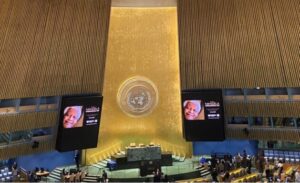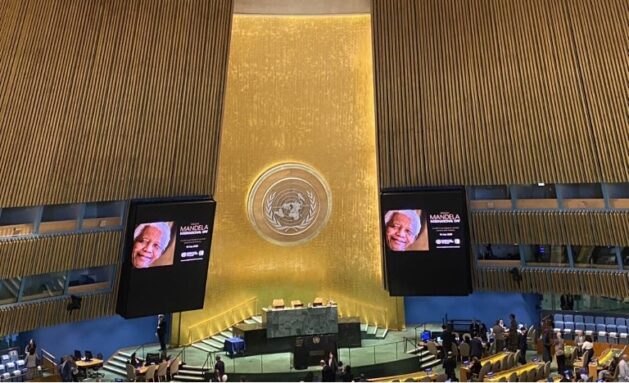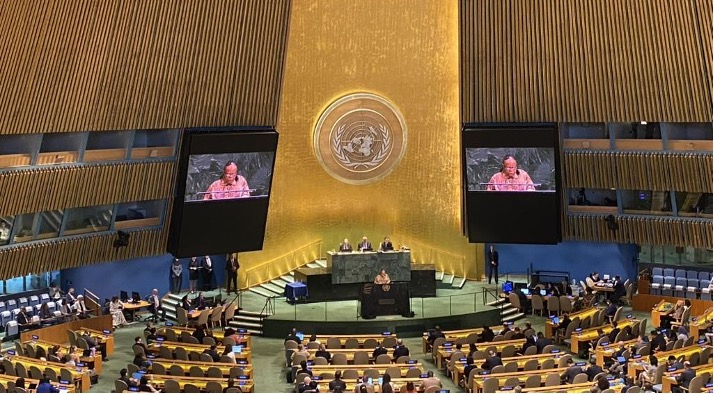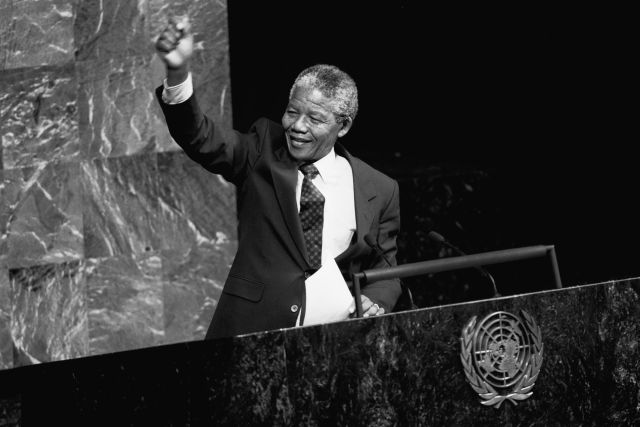
Armed Conflicts, Civil Society, Disaster Management, Editors’ Choice, Europe, Featured, Headlines, Human Rights, Humanitarian Emergencies, Sustainable Development Goals, TerraViva United Nations

The home of Oksana Serhienko, Merefa village, near Kharkiv, Ukraine. Credit: Akos Stiller
– As Russian forces continue to lay waste to civilian areas of towns and cities across Ukraine, Roma in the country are struggling to access compensation to help them rebuild their damaged homes.
Russia’s relentless bombing has, according to the World Bank, left 13 percent of Ukraine’s housing damaged or destroyed, affecting over 2.5 million households.
Despite this, many Ukrainians, including Roma, have refused to leave their homes in the face of relentless bombing and instead are determined to carry on living in sometimes severely damaged homes to keep their communities alive.
But a new report has shown that many Roma—one of the most vulnerable communities in Ukraine—have been unable to access state property damage compensation: only 4 percent of Roma households surveyed successfully secured compensation for war damage, despite suffering widespread destruction.
This is because requirements for applicants mean the Roma population, whose lives were already precarious long before the war began, are being disproportionately excluded from the scheme, according to the Roma Foundation for Europe (RFE), which was behind the report.
“Many of the issues we identify [in our report] affect non-Roma applicants too—particularly in occupied or frontline areas… [but] what makes the situation more severe for Roma is the combination of these factors with long-standing exclusion and economic precarity,” Neda Korunovska, Vice President for Analytics and Results at RFE, told IPS.
As in many countries in Europe, the Roma community in Ukraine has long faced social exclusion and, many claim, systemic discrimination at societal and institutional levels.
But like the rest of Ukrainian society, they have felt the full effects of Russia’s brutal full-scale invasion over the last three and half years and many have seen their homes damaged or even destroyed.
State compensation for property damage caused by the fighting is available, but experts say there are significant barriers for claimants, some of which are specifically greater for Roma people.
These include requirements such as possession of official property documents and proof of ownership—both sometimes difficult for Roma from communities where informal housing and disputed property rights are not uncommon—as well as a need for a level of digital literacy, which can be a problem for communities where levels of digital exclusion are high, according to RFE.
The group’s analysis, based on cases across four Ukrainian regions, including Zaporizhzhia, Kryvyi Rih, Odessa and Kharkiv, shows that deeply entrenched legal, administrative, and digital hurdles are blocking Roma communities from accessing aid intended for rebuilding homes and lives, the group claims.
Zeljko Jovanovic, RFE president, said that current compensation systems, although designed for order and efficiency, often overlook those with fewer resources but no less damage, and that they lack “…the required flexibility for the complex realities of pre-war informality of homes, displacement, and occupation.”
“Many affected families cannot afford the property registration fees or the costs associated with inheritance procedures. The average damage of 2,816 Euros represents several months of pre-war salary,” he added.
RFE points out that in regions like Odesa, more than half (54 percent) of Roma families lack formal property registration, while in Kryvyi Rih, not a single claim from the surveyed households has been submitted to the state registry due to legal limbo over inheritance, missing paperwork, and lack of resources to navigate the system. Even in Zaporizhzhia, where property records are strongest, low application rates point to deep mistrust in institutions, amplified by experiences of discrimination.
Some Roma contacted for the survey said they had not even bothered to apply for compensation for fear that the government might later come and demand the money back from them.
“This is a reflection of deep institutional mistrust,” said Korunovska. “This mistrust isn’t unfounded—it’s rooted in long-standing patterns of discrimination. In previous research we have undertaken, many Roma respondents have described negative treatment by public officials when seeking housing or services. Surveys consistently show high levels of social distance between Roma and the broader population in Ukraine, which reinforces these feelings of exclusion.”
RFE points out that nationally, around 61% of submitted claims have been approved, but that among Roma, the figure was only 28%—and the vast majority (86%) of people surveyed for its report never submitted claims at all due to systemic barriers.
Liubov Serhienko, 69, has lived in her home in Merefa, near Kharkiv, for the last forty years. But it has suffered severe damage from bombings by Russian forces—during one attack the roof and some ceilings collapsed and one room is now entirely uninhabitable. During a short evacuation from the house, thieves stole her boiler, fridge, and furniture.
Her daughter, Oksana, describes how the family—three generations all living under the same roof, including Oksana and her children—is forced to use blankets to try to retain whatever heat they can in rooms now largely completely exposed to the outside because walls are no longer standing. In winter, snow blows straight into the home, she says.
While neighbors have helped with some repairs, resources are limited and the building remains in disrepair. Relying solely on her pension of 3,000 UAH (around €70) to support the household—the war has taken away all job opportunities for her and members of her family—she says all she wants is the state to help fix the roof and ceiling, as she no longer has the physical strength or finances to do it herself.
In testimony to RFE, which was passed on to IPS, Serhienko said, “What I want most right now is for my family to have a roof over their heads.”
Oksana criticizes the lack of help from the state for them and other Roma in similar situations.
“The government doesn’t care. They’ve done nothing,” she said.
Her mother goes even further, explicitly linking her experience to deliberate discrimination by authorities.
“[Just] Gypsies, they say. As if we’re not people. Maybe they don’t see us as people.”
Andriy Poliakov has stayed in his home in Andriivka in the Kharkiv region since the start of the full-scale invasion, despite the severe damage the dwelling has suffered in Russian attacks.
Windows are broken and there are cracks in the walls, as he has suffered several damages to their house, windows were broken, and there are cracks in the walls, as his house has shifted structurally due to bomb blasts. Poliakov, 45, refuses to leave his home, as he is a sole caregiver for some members of his family, even though he is disabled himself, but he says life is difficult, as they have no gas or other reliable heating source and rely on a makeshift stove he built from stone and bricks.
As with almost all of those surveyed in the RFE report, Poliakov has had no help from the state with any of the damage to his home. One of the reasons so many Roma choose not to even attempt to apply for compensation is the distrust of authorities that is widespread among communities—a distrust Poliakov shares.
“They don’t care. Even though I’m disabled and it’s on paper that I’m disabled… It doesn’t matter to them,” he said.
In the wake of its findings, RFE is calling on the Ukrainian government to integrate urgent reforms into reconstruction planning, including accepting alternative proof of ownership such as utility bills or community testimony, waiving registration fees for war-affected families, and introducing temporary ownership certificates to ensure displaced or undocumented Roma have access to compensation.
RFE says it is hoping to present its findings to government representatives in the coming weeks.
“We hope this data will serve as a constructive basis for reform, especially in light of Ukraine’s broader efforts to align with European values of fairness and accountability,” said Korunovska.
Jovanovic added that “even if full compensation isn’t possible now, temporary support is essential. Roma living in damaged homes are part of Ukraine’s strength and its resistance.”
IPS UN Bureau Report












